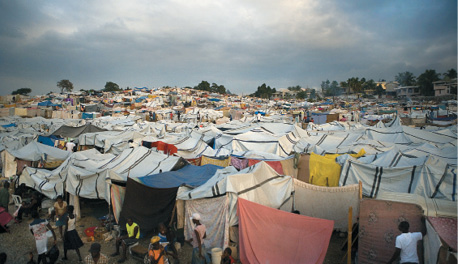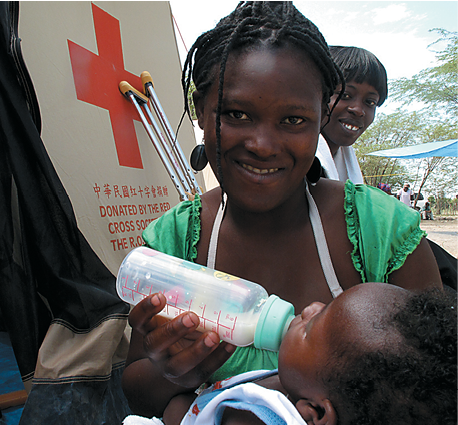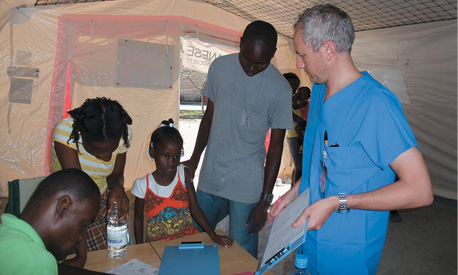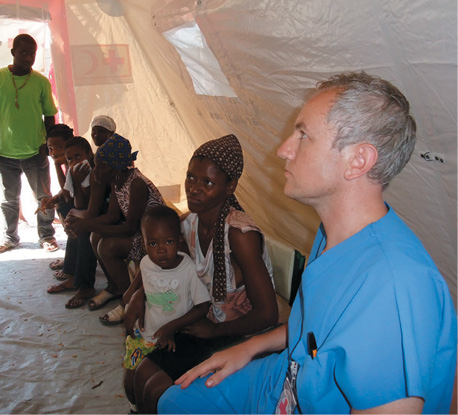
Part of a global disaster management network, Australian Red Cross is playing an active role in the Haiti relief and recovery operation.
The impact of the 12 January earthquake off the coast of Haiti has left even veteran disaster responders stunned. The magnitude-7.3 earthquake – the biggest to hit Haiti for 200 years – may have left as many as 200,000 people dead and more than a million homeless.
The quake leveled urban landscapes in parts of the country’s capital Port-au-Prince and surrounding suburbs and towns, leaving homes, businesses, banks, parks, marketplaces and schools in ruins.

Camp Daihatsu, an internally displaced persons camp in Port-au-Prince.
With an epicentre only 15 kilometres from Port-au-Prince – hub of a centralised administration – the earthquake struck at the heart of the country. It caused major damage to the seaport, airport and roads, destroyed parliament and ministry buildings, closed hospitals and crippled the city’s telecommunications, water and electricity supply.
The devastation caused by the earthquake has generated one of the largest humanitarian responses ever carried out in a single country. For the global Red Cross network, currently playing a key role in the emergency response, it is fast becoming one of the largest and most complex operations in recent memory.
The earthquake compounded pre-existing difficult living conditions in Haiti. Ranked 149 on the Human Development Index, 80 per cent of Haiti’s 8.7 million inhabitants were living in poverty prior to 12 January 2010, with half of the population subsisting on less than $1 a day.
Alongside poverty, the country’s deeper problems included political and social instability with an economy in ruins, chronic unemployment, overwhelming challenges in health, as well as severe deforestation and environmental degradation that undermined farming, inflated food prices, and left the country vulnerable to flooding.
As Tadateru Konoé, president of the International Federation of Red Cross and Red Crescent Societies (IFRC), observed of relief efforts in the aftermath of the earthquake: ‘We must confront a natural disaster that is not only one of the biggest of the past decade, but is affecting one of the very poorest countries in the world’. The Haiti earthquake left people in need of more than simple recovery.
As part of its global approach to disaster preparedness and management, the Red Cross movement is led by its local society in a disaster zone. Local Red Cross staff and volunteers are usually already involved in relief efforts before international assistance arrives. They are familiar with the communities and context in which they are working and ensure that additional assistance is needed and appropriate.

Scenes from Haiti, two weeks after the island was hit by 9.7 magnitude earthquake on 12 January, 2010.
Only moments after the earthquake struck on 12 January, Haitian Red Cross volunteers – many of whom were also left homeless and grieving, lost or missing loved ones – began to assess the impact and administer first aid to the injured. Prepositioned stores of relief items in Port-au-Prince provided an immediate source of aid to approximately 3,000 families. Items included blankets, hygiene kits, tarpaulins and containers for storing drinking water.
Also pre-positioned were funds held by IFRC. Within hours of the earthquake, IFRC had released money from its disaster relief emergency fund to cover the purchase and transfer of additional relief supplies, including food and water from neighbouring Dominican Republic. An international appeal for funds to support response and recovery work soon followed.
Key needs in the emergency relief phase included search and rescue, identification and management of dead bodies, medical assistance and the distribution of immediate relief items including food, clothing, water, shelter and sanitation. Shelter and sanitation continue to remain priorities.
Australian Red Cross immediately offered its support and assistance as part of the global Red Cross response. Within hours of hearing news of the disaster, the organization established a national appeal through which Australians could contribute to Red Cross relief and recovery efforts. To date, more than $7 million has been donated by the Australian public, businesses and government.
Australian aid workers, trained and experienced in disaster response, were immediately put on standby as Australian Red Cross awaited requests for resources from staff in the field. The first Australian Red Cross aid worker, a specialist in public health, travelled to Haiti six days after the earthquake. He complemented a team of Japanese Red Cross medical staff tending to the injured out of a temporary basic health care unit set up in a suburb outside Port-au-Prince.
Since then, fourteen Australian aid workers have travelled to Haiti; eight nurses, a midwife, a GP and three experts in shelter and a public health specialist. The medical teams are working with colleagues from across the world in a German Red Cross field hospital. One shelter specialist has joined the committee of 26 organisations overseeing the coordination of shelter activities (Red Cross has taken on the role of lead organisation on shelter), while the other two have joined Finnish Red Cross workers erecting tents and tarpaulins in attempts to provide people with emergency shelter.
Australian Red Cross has also contributed aid supplies, redirecting to Haiti a stock replenishment en route to its storage warehouse in Kuala Lumpur.

Marianne Joseph drinks fresh water from a tank set up by the French Red Cross.
More than six hundred international Red Cross aid workers from 37 countries have travelled to Haiti to assist the 10,000-strong staff and volunteer base from Haitian Red Cross.
A record 21 emergency response units – pre-trained teams of specialists from around the world with pre-packed sets of standardised equipment ready for immediate use in emergencies – were flown in from nearby countries in the days that followed. These included self-contained hospitals, as well as health, relief and shelter, water and sanitation, logistics, and communications units.
Logistics, water and medical treatment were immediate priorities for Red Cross, with first aid and water points quickly established in the affected areas. A large base camp was quickly established in Port-au-Prince and relief distribution points were set up in a number of locations in and around the capital. A major distribution point was established in the Dominican Republic’s Santo Domingo due to the challenges posed by damaged air and seaport facilities in Haiti.
To date, up to 2000 patients are being treated daily by medical professionals and 7 million litres of clean drinking water are being produced and distributed in 112 different locations each day. One hundred and fifty thousand people have benefited from an emergency vaccination campaign and more than 16 million messages containing health, shelter and sanitation information have been sent via blast SMS.

Courtesy: Christopher Cliffe, Australian Red Cross
Australian aid worker, Christopher Cliffe and his colleagues spent each day working through a steady stream of patients injured during the earthquake.
Although the humanitarian situation continues to improve on a daily basis, it is clear there are major unmet needs, particularly in terms of shelter and sanitation.
In the capital, tens of thousands of people are struggling in hundreds of makeshift camps. With the rainy season due to begin in May and the hurricane season in June, the situation is made more critical.
While the delivery and distribution of tents and shelter materials is being sped up, with more than 75 per cent of the displaced population having received shelter to date, the operation is severely constrained by the pre-existing shortage of land for new settlement. Work continues with Haitian authorities to identify additional appropriate sites for displaced people.
Of equal concern, Port-au-Prince was left without sanitation. So far more than 1200 latrines have been built in 20 different improvised camps, however more needs to be done before the rains hit. Aid workers are well aware that if conditions worsen, so too will the risk of potential epidemics of water-borne disease.
The recovery process will take years – perhaps even a generation – however aid workers are looking at this response as a rare opportunity to effect large-scale change where it is desperately needed.
Red Cross is committed to ensuring that Haiti’s devastated communities receive not only the help they need now, but the help they will need for a long while to come, with disaster response units now routinely including recovery experts to ensure community needs are understood and planned for. In addition, all work being undertaken by international aid workers is done in cooperation with Haitian Red Cross, with capacity development of the local society an ongoing focus for the global effort.
Longer term planning of recovery activities is well underway and will form the base upon which work will be implemented in the future.

Courtesy: Christopher Cliffe, Australian Red Cross
Christopher Cliffe and patients.

Courtesy: International Federation of Red Cross
Aerial shot of the German Red Cross hospital where Australian Red Cross aid workers have been stationed. This hospital was set up in a sports ground in Carrefour.